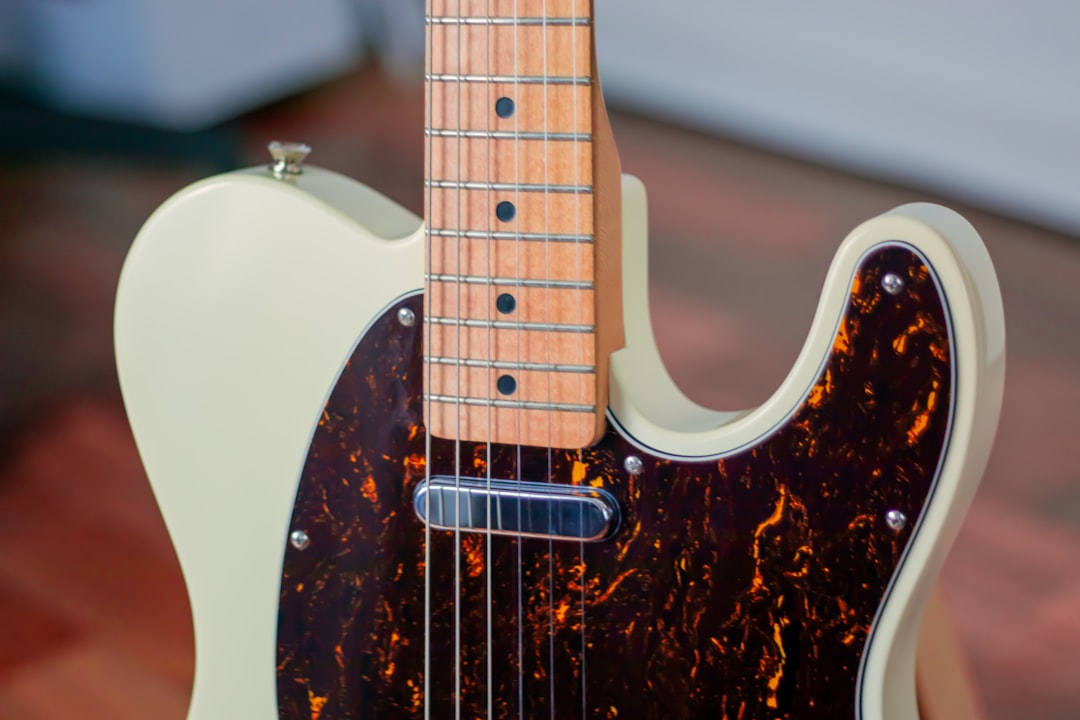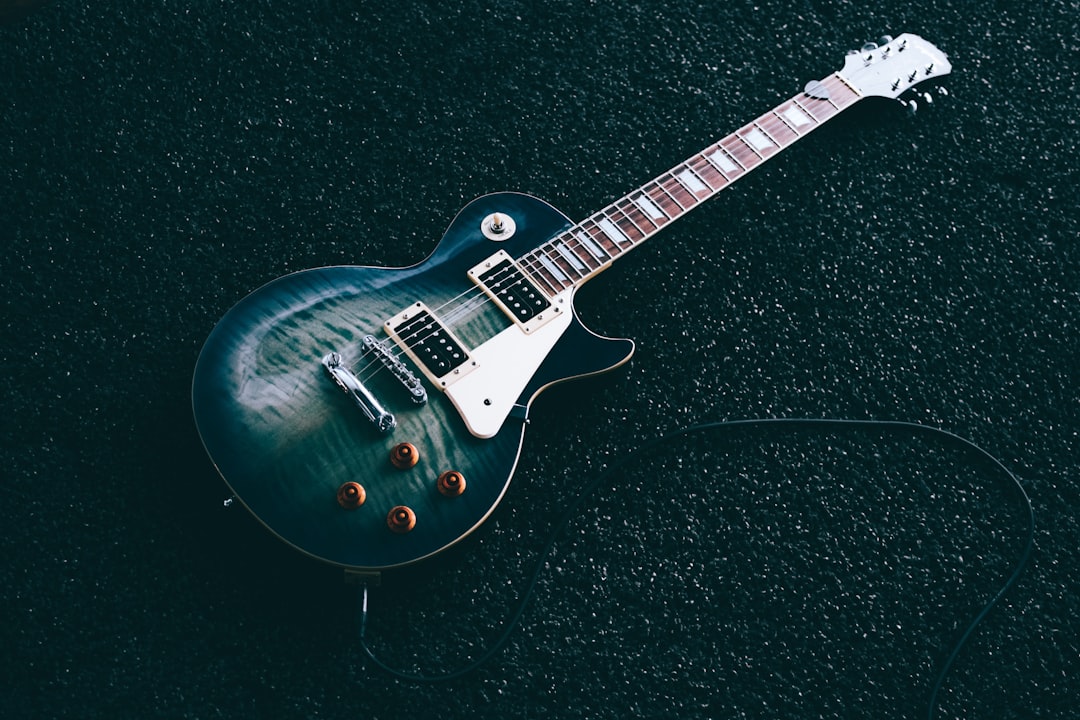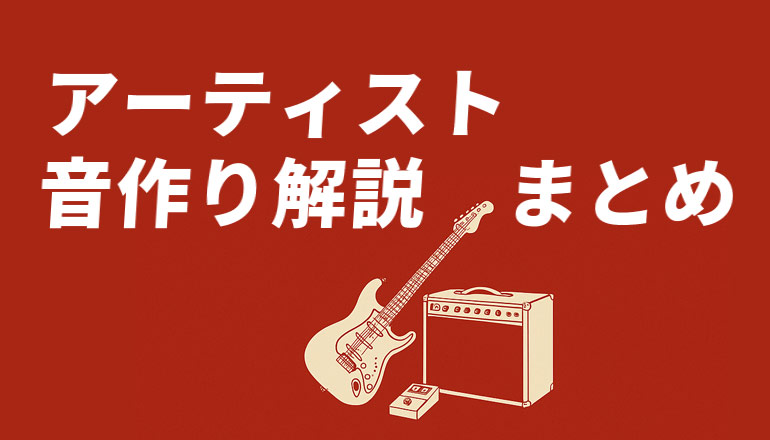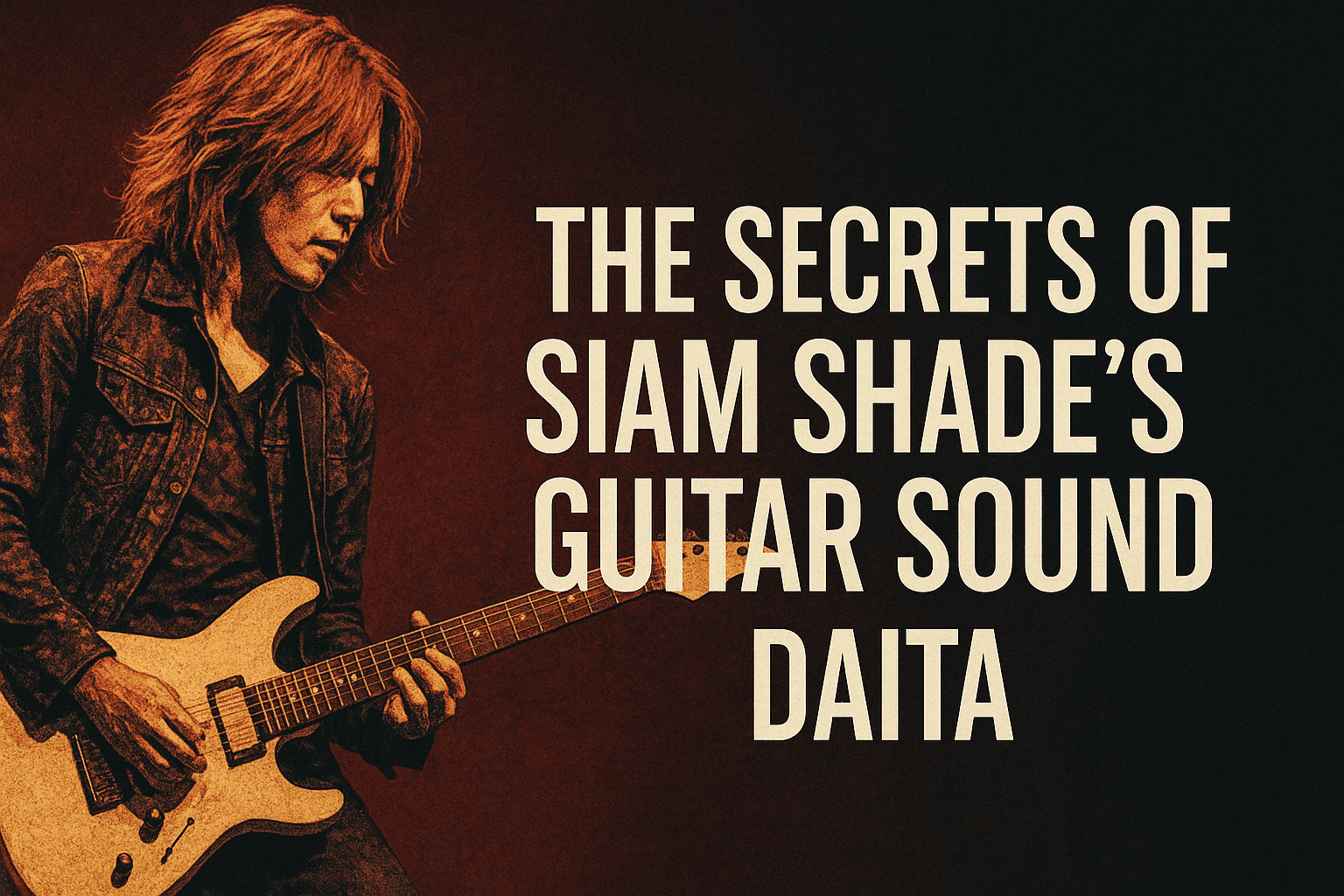- Introduction: The Signature Style of DAITA
- Amp Setup & Features: DAITA’s Gear Through the Years
- Guitars Used by DAITA: Craftsmanship and Customization
- Effects and Pedalboard Setup: DAITA’s Dual-Board Precision
- Tone Design, EQ Settings, and Live Mixing Techniques
- Affordable Gear Alternatives: Recreating DAITA’s Tone on a Budget
- Conclusion: The Philosophy Behind DAITA’s Tone
Introduction: The Signature Style of DAITA
DAITA, the guitarist of legendary Japanese rock band SIAM SHADE, is widely regarded as one of the few true guitar heroes to emerge from Japan’s music scene. During the band’s peak in the 1990s, he demonstrated exceptional technical prowess at the young age of 22–23, effortlessly navigating both rhythm and lead guitar parts with precision and flair.
What defines DAITA’s sound is his wide-ranging guitar technique—odd time signatures, fast alternate picking, tapping, fingerpicking, and intricate whammy bar work—all woven together into a unique and aggressive melodic style. Even SIAM SHADE’s vocalist, Hideki, once described him as “a super guitarist among super guitarists.”
His tonal palette ranges from pristine clean arpeggios to intense high-gain distortion, seamlessly adapting to the musical dynamics of songs like “Dreams,” “1/3 no Junjou na Kanjou,” and “HEART.” Beyond performing, DAITA now heads his own guitar brand, G-Life Guitars, where he’s involved in everything from guitar design to developing custom effect processors—highlighting his uncompromising dedication to tone craftsmanship.
▶ Search official SIAM SHADE music videos on YouTube
Amp Setup & Features: DAITA’s Gear Through the Years
DAITA’s amp rig has undergone significant evolution over the years. Back in the SIAM SHADE era, his primary amplifier was the Mesa/Boogie Mark III—a legendary head known for its exceptional clarity and midrange articulation. This amp allowed DAITA’s technical prowess, such as speedy runs and tapping, to shine through with incredible definition, covering everything from cleans to saturated high-gain tones.
In his current live setup, DAITA employs a much more complex and multi-amp system. Visually unified with black tolex finishes, his stage rig includes a center-mounted Orange PPC412 cabinet for dry tones, flanked by three Orange PPC212 cabinets on each side for stereo effects. The signal routing allows him to blend or separate dry and wet signals depending on the song.
For power amps, he uses two Bogner Ecstasy heads placed offstage, which serve purely as power sections. Tone shaping is handled through a sophisticated rack-based preamp setup that includes two Mesa/Boogie Tri Axis units, a Soldano X-99 Caswell, and a Marshall JMP-1. Each preamp offers distinct tonal characteristics—Tri Axis for tight modern lead tones, Soldano for aggressive high-gain, and JMP-1 for classic British voicing—giving him full tonal flexibility on demand. This system reflects DAITA’s meticulous approach to live sound, where instant access to varied tones is essential.
Main Amplifiers Used:
| Model | Manufacturer | Amazon Link | Artist | Guitarist | Notes |
|---|---|---|---|---|---|
| Mark III | Mesa Boogie | Amazon JP | SIAM SHADE | DAITA | Used extensively in the SIAM SHADE era; tight response and ideal for fast picking |
| Tri Axis | Mesa Boogie | Amazon JP | SIAM SHADE | DAITA | Rack-mounted preamp, used in stereo configuration |
| Ecstasy Head | Bogner | Amazon JP | SIAM SHADE | DAITA | Used solely as a power amp in modern live setup |
| X-99 Caswell | Soldano | Amazon JP | SIAM SHADE | DAITA | Offers aggressive high-gain voicing; rack-mounted |
| JMP-1 | Marshall | Amazon JP | SIAM SHADE | DAITA | Classic British tone; used selectively in live setup |
| PPC412 | Orange | Amazon JP | SIAM SHADE | DAITA | Center dry cab on stage |
| PPC212 | Orange | Amazon JP | SIAM SHADE | DAITA | Side stereo effect cabs |
Guitars Used by DAITA: Craftsmanship and Customization

DAITA has consistently demonstrated a strong commitment to quality when selecting guitars throughout his career. During his time with SIAM SHADE, he used a range of high-end guitars from Tom Anderson, Schecter, ESP, and PRS. One of the most iconic moments was the appearance of a red 10-top PRS Custom 24 in the music video for “LOVE.” He also used a green PRS CE 22 for club tours and continued to favor PRS models during international appearances such as G3.
Today, DAITA’s primary instruments are models from his own brand, G-Life Guitars, which he personally oversees and co-develops. His current favorites include the DSG Life Ash Midnight Blue Moon, DSG Premium Bora Bora Ocean Blue, and the G-Phoenix Custom Stardust Blue Moon. These guitars feature striking blue finishes and are custom-built with DAITA’s performance standards in mind—from premium tonewoods to neck shape, fretwork, and custom pickup configurations tailored to his signature style.
He still occasionally uses a Tom Anderson Classic, particularly one finished in Bora Bora Blue—a visually stunning guitar that stands out on stage. For acoustic or flamenco-style passages, he opts for a Godin ACS Slim Black, an electric-classical hybrid that provides a warm, precise tone. With G-Life Guitars, DAITA goes far beyond aesthetics: each model is engineered to meet the demands of techniques like high-speed shredding and complex tapping, while maintaining perfect tonal balance and player comfort.
Thanks to this philosophy, G-Life Guitars have earned recognition among professionals both in Japan and abroad as performance-ready, boutique-quality instruments.
| Model | Brand | Amazon Link | Artist | Guitarist | Type | Notes |
|---|---|---|---|---|---|---|
| DSG Life Ash Midnight Blue Moon | G-Life Guitars | Amazon JP | SIAM SHADE | DAITA | Electric Guitar | Main signature model produced by DAITA |
| DSG Premium Bora Bora Ocean Blue | G-Life Guitars | Amazon JP | SIAM SHADE | DAITA | Electric Guitar | High-end premium series model |
| G-Phoenix Custom Stardust Blue Moon | G-Life Guitars | Amazon JP | SIAM SHADE | DAITA | Electric Guitar | Customized model from the G-Phoenix series |
| Classic Bora Bora Blue | Tom Anderson | Amazon JP | SIAM SHADE | DAITA | Electric Guitar | A trusted model since the SIAM SHADE era |
| Custom24 (10-top red) | PRS | Amazon JP | SIAM SHADE | DAITA | Electric Guitar | Featured in the “LOVE” PV; highly iconic |
| ACS Slim Black | Godin | Amazon JP | SIAM SHADE | DAITA | Electric Nylon Guitar | Used for acoustic/flamenco-style parts |
| Blue Life | G-Life Guitars | Amazon JP | SIAM SHADE | DAITA | Electric Guitar | One of G-Life’s core blue-finish models |
Effects and Pedalboard Setup: DAITA’s Dual-Board Precision
DAITA’s effects rig is nothing short of sophisticated. His live setup includes two meticulously organized pedalboards positioned on stage. The main board, placed at the front right, includes a Fulltone CLYDE Standard Wah, a Sho-Bud Volume Pedal, a Visual Sound Visual VOLUME, and the VooDoo Lab Ground Control Pro, which functions as the master controller for his entire system. The back row of this board also houses a KORG Pitchblack+ tuner, a VooDoo Lab Pedal Power 2 Plus, and a junction box for signal routing.
The secondary board, positioned to the left, is loaded with more specialized effects. It includes an ERNIE BALL MVP (Most Valuable Pedal) active volume pedal, a MORLEY Bad Horsie 2 Wah, and two pitch-shifting units—the Digitech Whammy Ricochet and Digitech Whammy DT. These effects allow DAITA to achieve complex harmonies and dynamic pitch modulation during solos and ambient passages.
Behind the scenes, his rack system houses a wide range of boutique and custom effects. This includes two G-Life Guitars Gemini Boosters (his own design), an xotic SP Compressor, BamBasic Volume Upper, SONOMATIC Standard Ruby Booster, Bogner Ecstasy Blue, MXR Distortion+, D3 Audio Designs Cream Crunch, and the G-Life Guitars Black Buster. All rack units are controlled via the RJM Mini Effect Gizmo for seamless switching during live shows.
His signal chain is further enhanced by top-tier processors such as the TC Electronic TC 2290 delay unit, the Fractal Audio AXE-FX III multi-effects processor, and the Empirical Labs Distressor for dynamic shaping. Notably, he continues to use legacy gear like the BOSS VF-1 and TC Electronic Fireworx, showcasing a deep trust in tools that have stood the test of time in his tone architecture.
| Model | Manufacturer | Amazon Link | Artist | Guitarist | Effect Type | Notes |
|---|---|---|---|---|---|---|
| CLYDE Standard Wah | Fulltone | Amazon JP | SIAM SHADE | DAITA | Wah Pedal | Right-front position on the main board |
| Bad Horsie 2 | MORLEY | Amazon JP | SIAM SHADE | DAITA | Wah Pedal | Left board wah for aggressive tonal sweeps |
| Whammy Ricochet | Digitech | Amazon JP | SIAM SHADE | DAITA | Pitch Shifter | Compact, momentary pitch effect pedal |
| Whammy DT | Digitech | Amazon JP | SIAM SHADE | DAITA | Pitch Shifter | Advanced pitch shifting and drop tuning |
| Tremor | BBE | Amazon JP | SIAM SHADE | DAITA | Tremolo | Rear left section of the left board |
| Ripple | JAM Pedal | Amazon JP | SIAM SHADE | DAITA | Phaser | Rear center-right of the left board |
| the BIG CHiLL | JAM Pedal | Amazon JP | SIAM SHADE | DAITA | Tremolo | Rear right section of the left board |
| Gemini Booster | G-Life Guitars | Amazon JP | SIAM SHADE | DAITA | Booster | Custom-designed, used in rack drawer |
| SP Compressor | xotic | Amazon JP | SIAM SHADE | DAITA | Compressor | Compact and transparent compression |
| Ecstasy Blue | Bogner | Amazon JP | SIAM SHADE | DAITA | Overdrive | Used for warm, high-gain leads |
| Distortion+ | MXR | Amazon JP | SIAM SHADE | DAITA | Distortion | Classic tone; tight and focused |
| Black Buster | G-Life Guitars | Amazon JP | SIAM SHADE | DAITA | Distortion | Custom DAITA-designed distortion |
| TC 2290 | TC Electronic | Amazon JP | SIAM SHADE | DAITA | Delay | Classic delay, crucial for spatial tone |
| AXE-FX III | Fractal Audio | Amazon JP | SIAM SHADE | DAITA | Multi-FX Processor | High-end modeling and effects unit |
| VF-1 | BOSS | Amazon JP | SIAM SHADE | DAITA | Multi-FX Processor | Legacy unit, still in use from 90s |
| FIREWORX | TC Electronic | Amazon JP | SIAM SHADE | DAITA | Multi-FX Processor | Mainly used for reverb and ambient effects |
Tone Design, EQ Settings, and Live Mixing Techniques

The core of DAITA’s tone philosophy lies in building a guitar rig that can instantly switch between clean and ultra-high-gain tones—without sacrificing clarity or dynamics. This is accomplished not by simply toggling amp channels, but by seamlessly switching between multiple preamps, each fine-tuned for a specific tonal character.
For example, the Mesa/Boogie Tri Axis handles his clean and tight lead tones with a focus on midrange detail. The Soldano X-99 Caswell brings a more aggressive gain texture, perfect for soaring leads and heavy riffs. Meanwhile, the Marshall JMP-1 contributes that classic British roar, rounding out his sonic palette.
When it comes to EQ, DAITA prioritizes upper mids to enhance articulation, especially important for fast alternate picking and tapping techniques. Frequencies around 1 kHz are often boosted slightly to ensure every note cuts through the mix, even in complex phrasing. Bass frequencies below 100 Hz are typically reduced to tighten the low end, while highs around 3–5 kHz are accentuated to maintain presence and definition.
Each song gets its own customized tone profile. On tracks like “Dreams”, he leans on a clean tone with subtle compression and reverb, using the TC 2290 to create a wide, spatial feel. For heavier songs like “1/3 no Junjou na Kanjou”, he combines the Tri Axis with the Bogner Ecstasy Blue and pushes further with an MXR Distortion+ to generate a powerful, sustained tone suited for hard-hitting riffs.
Live, DAITA’s signal chain splits into dry and stereo wet paths. The dry sound is delivered from a center-mounted Orange PPC412 cabinet, while the wet stereo effects—reverb, delay, chorus—are routed to Orange PPC212 cabinets placed stage left and right. This 3D stereo spread ensures clarity from any seat in the audience, enhancing the immersive experience.
Thanks to the inclusion of a Fractal Audio AXE-FX III, his rig is capable of extremely intricate routing—such as adding distortion to only a specific frequency band during a tapping passage. Combined with careful coordination with front-of-house engineers, his team fine-tunes each preamp’s output to suit the acoustics of the venue, maintaining tonal consistency across different live settings.
Affordable Gear Alternatives: Recreating DAITA’s Tone on a Budget
While DAITA’s full rig is a dream setup for many, it’s possible to approximate his tone using more accessible gear—especially for those just getting started or working with a limited budget. The key lies in selecting equipment that emulates the tonal core of his setup: articulate mids, versatile gain structure, and dynamic response.
Amp Substitutes
Though vintage Mesa/Boogie heads can be expensive, used models like the Mesa Studio Caliber DC-2 or F-30 offer similar midrange clarity and wide tonal range. If you’re on a tighter budget, modern digital amps such as the BOSS KATANA-100 Head or Marshall DSL40CR offer solid amp modeling and sufficient gain structure to simulate DAITA-style tones—particularly when combined with the right effects.
Effects Alternatives
DAITA’s board features numerous boutique and custom pedals, but many of their sonic roles can be covered with more affordable options:
- BOSS DS-1 Distortion – Great for tight distortion, similar in character to MXR Distortion+.
- BOSS CH-1 Super Chorus – Delivers lush modulation perfect for SIAM SHADE’s clean sections.
- BOSS DD-8 or DD-7 Digital Delay – Excellent modern replacements for the TC 2290, offering stereo delay and hold functions.
- VOX V847-A Wah – Budget-friendly option offering vintage-style tone close to Fulltone CLYDE.
- BOSS PS-6 Harmonic Pitch Shifter – A compact alternative to the Digitech Whammy series, enabling harmony and octave effects.
Multi-FX and Modeling Units
Devices like the BOSS GT-1000CORE and LINE6 POD Go Wireless offer powerful routing options, amp simulations, and effects blocks that can replicate DAITA’s signal chain without requiring a complex pedalboard. While they may not capture the exact nuance of boutique gear, they provide excellent versatility and are gig-ready.
Budget Guitar Options
To emulate DAITA’s PRS-era tone from the SIAM SHADE days, the PRS SE Custom 24 is an ideal entry-level alternative. It includes coil-tap functionality, allowing you to switch between humbucking and single-coil tones—great for navigating both clean and high-gain sounds. If you’re on a stricter budget, guitars like the Epiphone Les Paul Standard or Ibanez RG550 (with HSH pickup configuration) offer wide tonal variation and excellent playability for shred-heavy passages.
| Type | Model | Manufacturer | Amazon Link | Artist | Guitarist | Notes |
|---|---|---|---|---|---|---|
| Amp | KATANA-100 Head | BOSS | Amazon JP | SIAM SHADE | DAITA | Versatile modeling amp with high-gain options |
| Amp | DSL40CR | Marshall | Amazon JP | SIAM SHADE | DAITA | British-style gain, ideal JMP-1 alternative |
| Distortion | DS-1 | BOSS | Amazon JP | SIAM SHADE | DAITA | Similar tone to MXR Distortion+ |
| Chorus | CH-1 Super Chorus | BOSS | Amazon JP | SIAM SHADE | DAITA | Perfect for lush clean tones |
| Delay | DD-8 | BOSS | Amazon JP | SIAM SHADE | DAITA | Delay with stereo and hold functions |
| Wah | V847-A | VOX | Amazon JP | SIAM SHADE | DAITA | Vintage-inspired wah at an affordable price |
| Pitch Shifter | PS-6 | BOSS | Amazon JP | SIAM SHADE | DAITA | Compact harmony/octave effect solution |
| Multi-FX | GT-1000CORE | BOSS | Amazon JP | SIAM SHADE | DAITA | Flexible alternative to AXE-FX III |
| Guitar | SE Custom 24 | PRS | Amazon JP | SIAM SHADE | DAITA | Closest affordable PRS-style option |
| Guitar | RG550 | Ibanez | Amazon JP | SIAM SHADE | DAITA | HSH pickup config for tonal versatility |
Conclusion: The Philosophy Behind DAITA’s Tone

To truly understand DAITA’s approach to guitar tone, one must look beyond the gear itself. His philosophy is rooted in the idea that guitar tone is a tool—a medium for delivering the emotional and musical message of a song. Every sonic choice he makes, from delicate clean arpeggios in “Dreams” to the intense riffs of “HEART”, serves the greater purpose of musical expression.
What sets DAITA apart is his uncompromising balance between tone quality and practicality. Whether designing guitars under the G-Life Guitars brand or assembling a live rig, every component is chosen not for hype, but for its reliability, feel, and how well it supports his playing style. Aesthetic beauty and raw performance are never mutually exclusive in his world—they’re inseparable.
Technically, one of the most remarkable aspects of his tone is the use of multiple preamps to define the foundational character of each sound. This isn’t simply about stacking effects, but about switching tonal personalities depending on the musical context. His use of Mesa/Boogie, Soldano, and Marshall preamps for different applications shows a level of tonal intentionality that goes beyond surface-level replication.
For those looking to emulate his tone, it’s essential to understand that DAITA’s gear choices are tightly woven into his playing technique. His fast picking and tapping aren’t just displays of speed—they’re an integral part of the emotional fabric of each composition. Therefore, replicating his sound means paying attention to details like midrange EQ and attack clarity, which highlight these techniques rather than drown them in distortion.
Ultimately, the most valuable takeaway from studying DAITA’s tone is this: gear is a means to an end, not the end itself. His rig has evolved with the times, yet the core philosophy remains unchanged—seek the sound that best serves the song. This mindset transcends brand names and budgets. Whether you’re using a top-tier boutique amp or a digital modeller, what matters most is knowing why you need a certain sound and crafting it with purpose.
By focusing not just on what DAITA uses, but how and why he uses it, guitarists everywhere can draw meaningful inspiration—turning tone crafting into a personal journey rather than a checklist of equipment.






